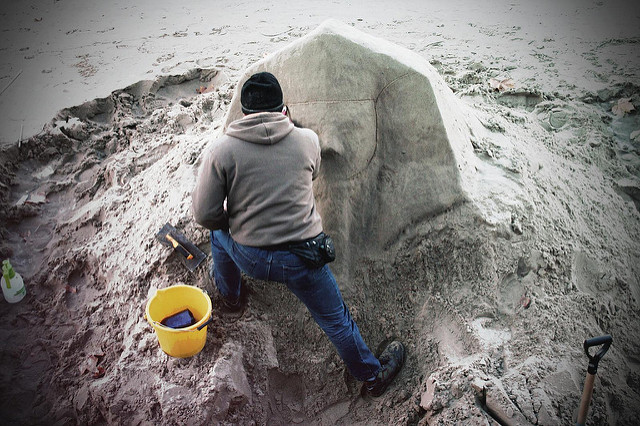Unlock the Magic in Your Story Now
Get the Free 20 questions to Ask Before Launching Your Idea workbook when you sign up for occasional updates.
Get the Free 20 questions to Ask Before Launching Your Idea workbook when you sign up for occasional updates.
Transactions Vs. Experiences
filed in Marketing, Storytelling, Strategy
 The hotel was nothing to write home about. You couldn’t really fault it either. The facilities, which matched the hotel’s star rating were as described. The room was clean. The bed was comfortable. The staff were efficient and polite. But—you knew there was a ‘but’ coming. The place lacked a spirit of generosity. It had no soul. There was no magic. It was as if the management had deliberately planned to deliver the minimum required to meet spec and no more. I got a room, and the hotel got my credit card details. A transaction took place.
The hotel was nothing to write home about. You couldn’t really fault it either. The facilities, which matched the hotel’s star rating were as described. The room was clean. The bed was comfortable. The staff were efficient and polite. But—you knew there was a ‘but’ coming. The place lacked a spirit of generosity. It had no soul. There was no magic. It was as if the management had deliberately planned to deliver the minimum required to meet spec and no more. I got a room, and the hotel got my credit card details. A transaction took place.
Every business has a story to tell about how discerning, disgruntled and sometimes downright demanding customers have become. It’s as if peoples’ expectations know no bounds. There’s another side to this story though. Our side. The story about what’s at stake for us as leaders, entrepreneurs and marketers. When we deliver the minimum required and deal only in transactions, we’re not only disappointing customers—we’re selling ourselves short in all kinds of ways that can’t be measured on a balance sheet at the end of the quarter.
Our customers subconsciously mirror our attitudes and behaviour. When we deal in transactions, we become transactional brands. When we go above and beyond, people know. When we are generous, they respond.
My friend James runs a thriving cafe in Fitzroy Gardens called KereKere. The cafe gets its name from the Fijian custom of giving without expecting anything in return. KereKere customers leave feeling that they got more than they paid for because James has intentionally built a business that creates experiences. James doesn’t believe in simply processing transactions.
The inadequacy of the adequate isn’t just that it leaves customers feeling flat, it’s that it denies us the opportunity to do our best, most meaningful work.
Image by Linh Nguyen
Share this article
Marketing Efficacy And Expectations
 When ‘meal replacement’ shakes first came to market they seemed like the answer to a dieter’s prayers. Replacing one or two regular meals with a calorie counted milkshake meant ingesting fewer calories, resulting in rapid weight loss. Meal replacements worked for some people for a little while. Those first few pounds often ‘fell off’. But monotony soon overcame motivation. Dieters gained weight as soon as they went back to eating real food.
When ‘meal replacement’ shakes first came to market they seemed like the answer to a dieter’s prayers. Replacing one or two regular meals with a calorie counted milkshake meant ingesting fewer calories, resulting in rapid weight loss. Meal replacements worked for some people for a little while. Those first few pounds often ‘fell off’. But monotony soon overcame motivation. Dieters gained weight as soon as they went back to eating real food.
The efficacy of the product failed to meet expectations. It’s not that the product didn’t work.
It’s just that it didn’t do everything the customer hoped it would do.
We have a similar problem when it comes to marketing. We sometimes expect our marketing messages to do too much heavy lifting and are disappointed with the results. It’s almost impossible for a marketing message to take a customer from awareness to action in a single leap. And yet, becoming the outlier is the holy grail of marketing. We dream of being the bestseller, the blockbuster, the breakthrough. Mostly we’re disappointed by our results.
Often the problem isn’t the efficacy of our marketing—it’s our expectations about the kind of change it’s possible to create, with the resources we have, in the time we’ve allowed. Two questions worth asking at the outset then—what are we asking this marketing message to do and is it reasonable to expect the result we want in the time we have?
Image by Paul Kelly
Share this article
Being Seen And Heard
 The numbers vary, but the trend is unmistakable. The average consumer is subjected to more marketing messages every day. In a world where it’s harder to get noticed marketers have responded by trying to be more visible. Being noticed is the goal of most marketing.
The numbers vary, but the trend is unmistakable. The average consumer is subjected to more marketing messages every day. In a world where it’s harder to get noticed marketers have responded by trying to be more visible. Being noticed is the goal of most marketing.
The irony is five seconds in the spotlight doesn’t make or break a career or a company. It’s the five years of work that preceded those five seconds that make all the difference.
Our goal isn’t simply to been seen and heard—it is to do work that’s worthy of being seen and heard.
Image by Blahu
Share this article
Another Time
 During a high-intensity workout, the trainer reminds the athlete to treat every set as if it were the last. To train as if this was the only sixty seconds, he would cycle that day. In that moment, with that mindset he increases his effort, his performance intensifies and that changes his results.
During a high-intensity workout, the trainer reminds the athlete to treat every set as if it were the last. To train as if this was the only sixty seconds, he would cycle that day. In that moment, with that mindset he increases his effort, his performance intensifies and that changes his results.
We often presume we will have time to do something over. That there will be another time to do our best work. Next time we’ll make more effort or do it better. What’s stopping us from doing it the best way we know how this time? If it’s worth doing why not act as if there won’t be another time?
It turns out that our results are determined by the little things we chose not to do each and every time, more than by the big thing we once did.
Image by Will
Share this article
The Slow And Steady Advantage
 The salespeople at our local gym usually interact with their customers once. A person who is motivated enough to book a gym tour, followed by the inevitable sales conversation is likely to join. The conversion rate is high. While designing the experience to optimise the quickest route to the sale works for the gym—it’s not a good model for most businesses.
The salespeople at our local gym usually interact with their customers once. A person who is motivated enough to book a gym tour, followed by the inevitable sales conversation is likely to join. The conversion rate is high. While designing the experience to optimise the quickest route to the sale works for the gym—it’s not a good model for most businesses.
Most businesses are sustained by multiple interactions with returning customers over time. Consistent engagement over time adds value, even when it doesn’t end in a sale.
Trust is an invaluable resource.
In our hurry to succeed we sometimes overlook the opportunity to engage first and sell later. Marketing works best when it’s anticipated, and the person on the other side of the interaction feels like they had a hand in the result.
Business is a marathon, not a sprint.
Image by Sue Langford
Share this article
People Power
filed in Marketing, Storytelling, Strategy
 When a traveller books a $700 a night hotel room she assumes that she’ll have a five-star experience. She’s expecting more than a better bed, thicker carpets and fancier facilities. When a five-star hotel gets a one-star review, it’s an indication that something went badly wrong.
When a traveller books a $700 a night hotel room she assumes that she’ll have a five-star experience. She’s expecting more than a better bed, thicker carpets and fancier facilities. When a five-star hotel gets a one-star review, it’s an indication that something went badly wrong.
Of course, guests and customers are disappointed for a variety of reasons. Reality can’t always meet expectations. Sometimes the room is noisy, or the food is cold. Maybe the shower is dirty, or the bed is uncomfortable. But these issues in isolation rarely result in a ‘terrible’ review.
When you analyse one-star reviews, a clear pattern emerges. It doesn’t matter whether the hotel’s room rate is $700 or $70 a night—every single one-star review is a result of human failure. It’s what happens in the moment when the customer seeks acknowledgement that changes everything.
The best product on the planet is rendered virtually worthless if the person delivering it fails to make a human connection with the customer. We want to be seen more than we want plush carpets beneath our feet or goose down pillows under our heads.
Image by Thomas Hawk
Share this article
To Do Or Not To Do
 We wake every day with solid ideas and imperfect plans.
We wake every day with solid ideas and imperfect plans.
And yet every day we stall.
We blame time.
We await readiness or motivation, or both.
We rationalise about tomorrow being better.
We make assumptions about what it takes to be good enough.
We allow doubt and uncertainty to take hold.
We wait. Forgetting that every unrealised opportunity hinged on the thing we decided not to do.
We must commit to acting when we can, while we can, because we can.
Image by Jon Nicholls
Share this article
Making A Mark
filed in Storytelling
 Regular customers know when Effie has the day off from her job at the city centre convenience store. They sense her absence as soon as they walk in. The coffee machine hasn’t been cleaned. The shelves haven’t been restocked. The music isn’t playing. Customers aren’t stopping to chat.
Regular customers know when Effie has the day off from her job at the city centre convenience store. They sense her absence as soon as they walk in. The coffee machine hasn’t been cleaned. The shelves haven’t been restocked. The music isn’t playing. Customers aren’t stopping to chat.
There’s a different energy about the place.
Over time, we’ve come to believe that making a mark is about doing the monumental—things few people could do. We’ve got that backwards. We change the world in imperceptible increments, by caring to do the things that anyone could do—but few choose to do.
Image by Can Pac Swire
Share this article
Forget Which Way The Wind Is Blowing
 When the disco diner opened on a warm Summer night in a flurry of pink neon, accompanied by loud music and cheap booze, the owner felt reassured he’d found his tribe. But as the evenings grew shorter and the nights colder, his confidence began to waver. The evolving messaging on a pair of sandwich boards obstructing the pavement outside was a sign that all was not well inside.
When the disco diner opened on a warm Summer night in a flurry of pink neon, accompanied by loud music and cheap booze, the owner felt reassured he’d found his tribe. But as the evenings grew shorter and the nights colder, his confidence began to waver. The evolving messaging on a pair of sandwich boards obstructing the pavement outside was a sign that all was not well inside.
The first board advertised the diner’s happy hour—$5 beers, wine and schooners from 4-7pm. The second advised that the kitchen was vegan-friendly and open until 1 am. An attempt to pick up customers who couldn’t get a table at the popular vegan taco place across the street.
The wind had clearly changed direction. Successful businesses don’t alter their marketing strategy according to which way the wind is blowing. They know who they are and who they’re for. They know what they’re good at and have a plan to be great at it. Successful brands don’t haphazardly take up the slack. They intentionally set out to do something worthy of becoming the chosen one.
Image by P. Monaghan
Share this article
Skill Vs. Talent
filed in Storytelling, Strategy
 The dentist looks inside the patient’s mouth. She completes her examination, makes an assessment and proposes treatment. The proposed treatment considers only two things. What’s going on inside the patient’s mouth and his ability to pay.
The dentist looks inside the patient’s mouth. She completes her examination, makes an assessment and proposes treatment. The proposed treatment considers only two things. What’s going on inside the patient’s mouth and his ability to pay.
The dentist knows she can fix the problem. She wants to do a good job. This is the work she’s trained for twenty years to do. But her training hasn’t equipped her to see that treatment isn’t only about executing flawless fillings. A good dentist assesses the mouth, then fills the tooth to relieve the pain. A great dentist looks the patient in the eye and understands why he’s worried about having a broken tooth before she thinks about drilling.
Proficiency and competence are a given. What patients, clients and customers want is someone who has the talent to see their problems in context. A professional who knows that they are more than the sum of their challenges and the contents of the wallets.
Image by My Future.